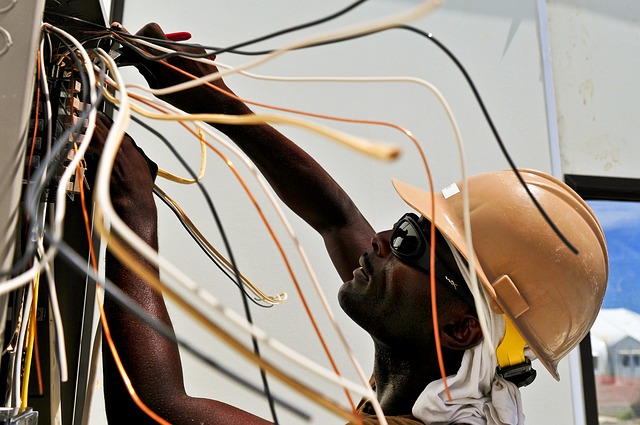Electrical installation
Contents |
[edit] Introduction
The term ‘electrical Installation’, with regards to electrical systems in buildings, may be considered as a verb or as a noun.
[edit] Electrical installation as a verb
Considering it firstly as a verb, electrical installation describes the physical work involved in installing electrical systems into a building.
Electrical installation work in this respect comprises all relevant activities, usually but not always limited to:
- Preparation work – such as cutting of holes, provision of fixings and supports.
- Physical installation of electrical wiring systems onto and within the building structure.
- Testing or wiring systems (usually for insulation resistance and to check for any damage).
- Installation of electrical equipment and its connection.
- Testing of electrical wiring and equipment – normally for compliance with BS 7671 (IET Wiring Regulations) Part 6 requirements.
- Production and issue of test certification and other handover documentation such as operation and maintenance details.
- Making good of finishes, sealing of holes and penetrations and particularly the provision of passive fire stopping in relation to this.
Stages 1 and 2 are often referred to in the trade as first fix activities, and usually precede the work of other trades such as plaster boarding, plastering, drylining, etc.
Stages 3 to 7 are then referred to as second fix activities and follow the work of other trades - often when cables have been concealed within the fabric of a building.
It is for this reason that best practice should be to test some of the wiring, usually for insulation resistance, before the connection of any equipment.
Note - The complete act of installation as defined above will often fall under different contracted parties. It is vital to establish clear boundaries and contract responsibilities before work is undertaken, particularly in areas such as building works, making good and fire stopping.
[edit] Electrical installation as a noun
Electrical installation as a noun is defined in BS 7671 as: ‘An assembly of associated electrical equipment having co-ordinated characteristics to fulfil specific purposes.’
Note also that BS 7671 defines ‘Electrical equipment’ as: ‘Any item for such purposes as generation, conversion, transmission, distribution or utilisation of electrical energy, such as machines, transformers, apparatus, measuring instruments, protective devices, wiring systems, accessories, appliances and luminaires.
As such, the electrical installation within a building would be the collective noun used to describe all of the aforementioned items.
--ECA
[edit] Related articles on Designing Buildings
- 18th Edition Wiring Regulations.
- Articles about electricity.
- BS 7671.
- Changing lives with the Practical Participation Programme
- Consumer electronics.
- Consumer units.
- Data cables and the CPR.
- ECA articles.
- Electrical appliance.
- Electrical component.
- Electrical conduit.
- Electrical consumption.
- Electrical energy.
- Electrical equipment.
- Electrical installation.
- Electrical power.
- Electrical safety.
- Electrical system.
- Electrical wiring
- Electrician.
- Electricity supply.
- Glossary of electrical terms.
- Industry backs leading fire and security awards.
- Modular housing and electrical circuitry.
Featured articles and news
RTPI leader to become new CIOB Chief Executive Officer
Dr Victoria Hills MRTPI, FICE to take over after Caroline Gumble’s departure.
Social and affordable housing, a long term plan for delivery
The “Delivering a Decade of Renewal for Social and Affordable Housing” strategy sets out future path.
A change to adoptive architecture
Effects of global weather warming on architectural detailing, material choice and human interaction.
The proposed publicly owned and backed subsidiary of Homes England, to facilitate new homes.
How big is the problem and what can we do to mitigate the effects?
Overheating guidance and tools for building designers
A number of cool guides to help with the heat.
The UK's Modern Industrial Strategy: A 10 year plan
Previous consultation criticism, current key elements and general support with some persisting reservations.
Building Safety Regulator reforms
New roles, new staff and a new fast track service pave the way for a single construction regulator.
Architectural Technologist CPDs and Communications
CIAT CPD… and how you can do it!
Cooling centres and cool spaces
Managing extreme heat in cities by directing the public to places for heat stress relief and water sources.
Winter gardens: A brief history and warm variations
Extending the season with glass in different forms and terms.
Restoring Great Yarmouth's Winter Gardens
Transforming one of the least sustainable constructions imaginable.
Construction Skills Mission Board launch sector drive
Newly formed government and industry collaboration set strategy for recruiting an additional 100,000 construction workers a year.
New Architects Code comes into effect in September 2025
ARB Architects Code of Conduct and Practice available with ongoing consultation regarding guidance.
Welsh Skills Body (Medr) launches ambitious plan
The new skills body brings together funding and regulation of tertiary education and research for the devolved nation.
Paul Gandy FCIOB announced as next CIOB President
Former Tilbury Douglas CEO takes helm.
UK Infrastructure: A 10 Year Strategy. In brief with reactions
With the National Infrastructure and Service Transformation Authority (NISTA).
























